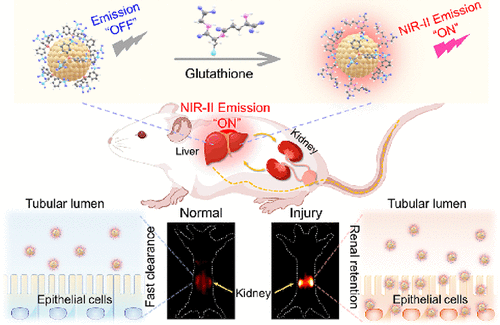Analytical Chemistry
- Oncology
Glutathione-Activated Emission of Ultrasmall Gold Nanoparticles in the Second Near-Infrared Window for Imaging of Early Kidney Injury
Authors Zhipeng Zhao, Huarui Chen, Kui He, Jincheng Lin, Wei Cai, Yidan Sun, and Jinbin Liu*
Abstract
Biomarker-activatable luminescent probes with high sensitivity and specificity show great promise in advanced bioimaging applications. However, the lack of stable biomarkers at an early stage is currently a major obstacle for sensitive early disease imaging. Herein, we develop a facile in vivo ligand exchange strategy to achieve renal-clearable activatable luminescent gold nanoparticles (AuNPs), which are independent of biomarkers for sensitive and long-time imaging of early kidney injury. Significantly activated emission in the second near-infrared region (∼1026 nm) is realized from the ligand exchange of triphenylphosphine-3,3′,3″-trisulfonic acid (TPPTS)-coated AuNPs (∼1.4 nm, TPPTS-AuNPs) with quantitative amounts of glutathione (GSH). The abundant GSH in cells, particularly in liver sinusoids, is then demonstrated successfully to activate the emission of TPPTS-AuNPs with an extremely low background for both cell imaging and in vivo visualization of visceral organs (e.g., liver and kidneys). In addition, the in vivo GSH-exchanged TPPTS-AuNPs show enhanced interactions with acidic renal tubular epithelial cells, resulting in sensitive (contrast index, ∼3.9) and long-time (>6.5 h) noninvasive monitoring of acidosis-induced early kidney injury. This facile ligand exchange strategy opens new possibilities for designing activatable luminescent probes independent of biomarkers for earlier disease diagnosis and treatment.

